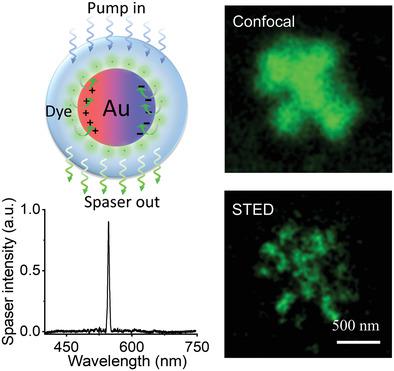当前位置:
X-MOL 学术
›
Adv. Mater.
›
论文详情
Our official English website, www.x-mol.net, welcomes your
feedback! (Note: you will need to create a separate account there.)
Spaser Nanoparticles for Ultranarrow Bandwidth STED Super-Resolution Imaging.
Advanced Materials ( IF 27.4 ) Pub Date : 2020-01-20 , DOI: 10.1002/adma.201907233 Zhaoshuai Gao 1 , Jian-Hua Wang 1 , Pei Song 1 , Bin Kang 1 , Jing-Juan Xu 1 , Hong-Yuan Chen 1
Advanced Materials ( IF 27.4 ) Pub Date : 2020-01-20 , DOI: 10.1002/adma.201907233 Zhaoshuai Gao 1 , Jian-Hua Wang 1 , Pei Song 1 , Bin Kang 1 , Jing-Juan Xu 1 , Hong-Yuan Chen 1
Affiliation

|
Super-resolution microscopy, as a powerful tool of seeing abundant spatial details, typically can only distinguish a few distinct targets at a time due to the spectral crosstalk between fluorophores. Spaser (i.e., surface plasmon laser) nanoprobes, which confine lasing emission into nanoscale, offer an opportunity to eliminate such obstacle. Here, realized is narrow band stimulated emission depletion (STED) nanoscopy on spaser nanoparticles by collecting the coherent spasing signals. Demonstrated are the physics concept and feasibility of erasing spaser emission by using a depletion beam to suppress the population inversion, which lays the foundation of spaser-based STED super-resolution. Thanks to the small size (47 nm) and narrow spectral linewidth (3.8 nm) of the spaser nanoparticles, a 74 nm spatial resolution in STED imaging within an acquisition bandwidth of 10 nm is finally obtained. These spaser nanoparticles, if multiplexing with different wavelengths, in principle, allow for spectral-multiplexed imaging, sensing, cytometry, and light operation of a large number of targets all at once.
中文翻译:

用于超窄带宽STED超分辨率成像的Spaser纳米颗粒。
超分辨率显微镜作为查看大量空间细节的有力工具,由于荧光团之间的光谱串扰,通常一次只能分辨出几个不同的目标。将激光发射限制在纳米级的Spaser(即表面等离子体激元激光器)纳米探针为消除此类障碍提供了机会。在这里,通过收集相干的打散信号,实现了对打散纳米颗粒的窄带激发发射耗尽(STED)纳米技术。演示了通过使用耗尽束抑制种群反转来消除Spaser发射的物理概念和可行性,这为基于Spaser的STED超分辨率奠定了基础。由于spaser纳米粒子的尺寸小(47 nm)和光谱线宽窄(3.8 nm),最终在10 nm的采集带宽内获得了STED成像中74 nm的空间分辨率。这些spaser纳米粒子,如果与不同的波长多路复用,则原则上可以同时对多个目标进行光谱多路复用的成像,传感,细胞计数和光操作。
更新日期:2020-03-03
中文翻译:

用于超窄带宽STED超分辨率成像的Spaser纳米颗粒。
超分辨率显微镜作为查看大量空间细节的有力工具,由于荧光团之间的光谱串扰,通常一次只能分辨出几个不同的目标。将激光发射限制在纳米级的Spaser(即表面等离子体激元激光器)纳米探针为消除此类障碍提供了机会。在这里,通过收集相干的打散信号,实现了对打散纳米颗粒的窄带激发发射耗尽(STED)纳米技术。演示了通过使用耗尽束抑制种群反转来消除Spaser发射的物理概念和可行性,这为基于Spaser的STED超分辨率奠定了基础。由于spaser纳米粒子的尺寸小(47 nm)和光谱线宽窄(3.8 nm),最终在10 nm的采集带宽内获得了STED成像中74 nm的空间分辨率。这些spaser纳米粒子,如果与不同的波长多路复用,则原则上可以同时对多个目标进行光谱多路复用的成像,传感,细胞计数和光操作。











































 京公网安备 11010802027423号
京公网安备 11010802027423号